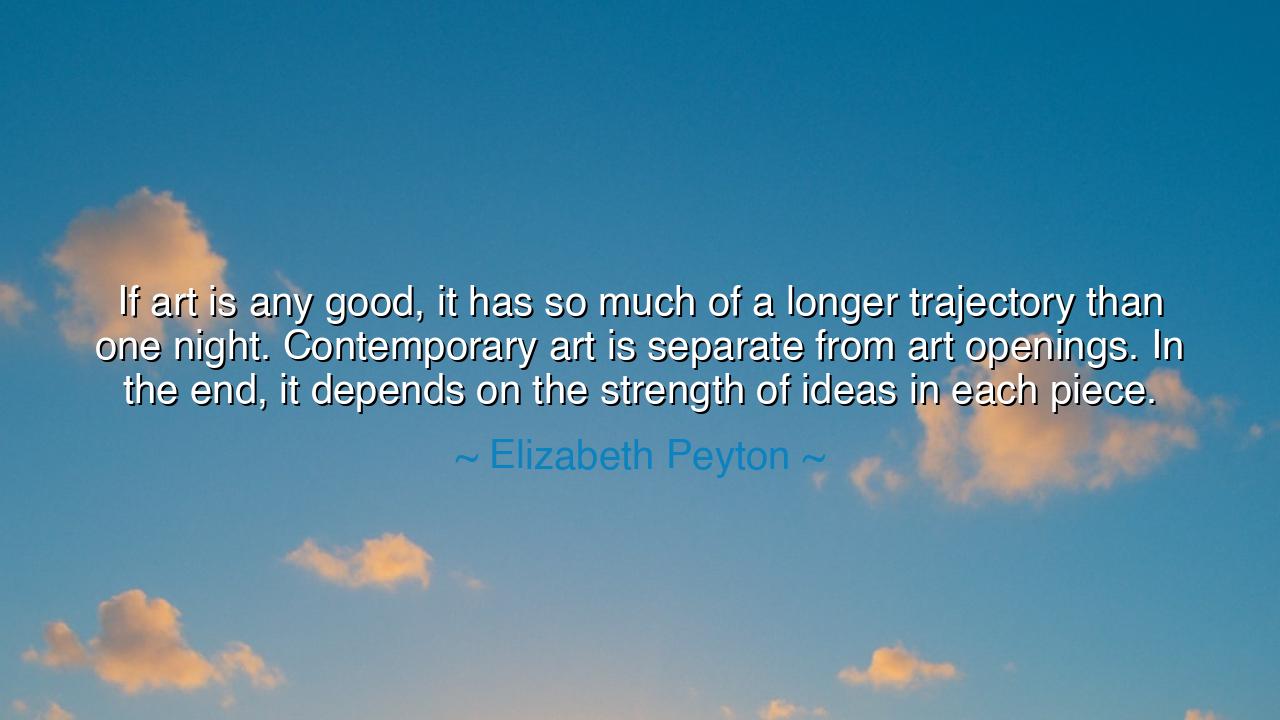
If art is any good, it has so much of a longer trajectory than
If art is any good, it has so much of a longer trajectory than one night. Contemporary art is separate from art openings. In the end, it depends on the strength of ideas in each piece.






Elizabeth Peyton, painter of modern faces and fleeting moments, once declared: “If art is any good, it has so much of a longer trajectory than one night. Contemporary art is separate from art openings. In the end, it depends on the strength of ideas in each piece.” In this reflection, she tears away the glitter of the temporary, the clamor of the crowd, the shallow judgment of a single evening. She reminds us that true art is not measured by applause or fashion, but by endurance—the ability of an idea to echo across time, to continue speaking long after the champagne has dried and the lights have dimmed.
The meaning of her words is profound. Peyton warns against the illusion that art is born for the gallery alone, or for the acclaim of a fashionable circle. One night of praise does not make a work immortal. Rather, the true measure of art lies in the strength of ideas that burn within it. A painting, a sculpture, a poem, or a song that carries a vision, that pierces into the core of human experience, will outlast its first reception. For the public may forget, critics may move on, but an idea infused with truth and beauty is eternal.
The origin of such wisdom comes from Peyton’s own place within the contemporary art world. Known for her portraits of cultural figures, she saw firsthand the fever of openings—crowds hungry for novelty, galleries filled with chatter and commerce. Yet she perceived that this momentary frenzy was not the true destiny of art. Art lives not in the clamor of openings, but in the silent communion between the work and the viewer, repeated across years and generations. By separating art from its social event, Peyton places it back in its sacred place: as a vessel for enduring vision.
History affirms this lesson. Consider Vincent van Gogh, whose works were mocked or ignored in his lifetime, his openings attended by few, his genius dismissed. Yet within each canvas lay ideas of color and emotion so strong that they broke forth after his death, reshaping all of modern art. His trajectory was not of a night, but of centuries. Or think of Emily Dickinson, whose poetry lay hidden in drawers, uncelebrated in her time, but carried the strength of such searing ideas that it now burns as a beacon of American letters. Their greatness lay not in openings, but in the strength of what they saw and expressed.
The imagery Peyton invokes is powerful: art with a longer trajectory. It is like an arrow loosed into the future, sailing beyond the noise of the present moment, striking hearts yet unborn. The opening night is but the bow; the true destiny of the work is in flight, in the generations who will look upon it and be moved. Thus, to an artist, the question is not, “Will they praise me tonight?” but, “Will my vision still speak when I am gone?”
The lesson for us, then, is not confined to art alone. Whatever we create—be it words, deeds, inventions, or acts of kindness—let them be rooted in strong ideas, not in the fleeting desire for recognition. Build for the long trajectory. Do not be seduced by the applause of the moment, but labor for the truth that will endure. For only what is rooted in depth, in conviction, in vision, will survive the erosion of time.
Practically, this means asking ourselves: what is the idea behind my work? What strength of vision gives it life? Am I creating to impress today, or to inspire tomorrow? Seek ideas that will endure, and pour them into what you make. Let each piece, each effort, carry something of your deepest truth, for that is what endures.
So let Peyton’s words stand as a guide for all who create: “It depends on the strength of ideas in each piece.” Do not chase the glitter of a single night. Aim instead for the arc of eternity. For art, if it is true, will outlive the moment of its unveiling, and in its strength of idea, it will go on speaking long after both artist and audience are dust. This is the destiny of greatness—not a night, but an age.






AAdministratorAdministrator
Welcome, honored guests. Please leave a comment, we will respond soon